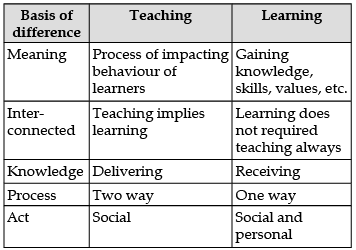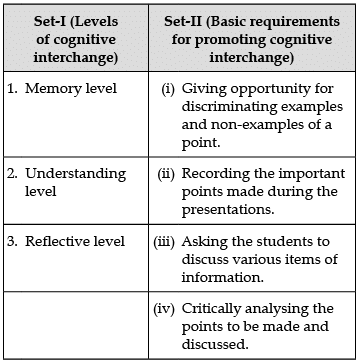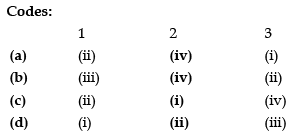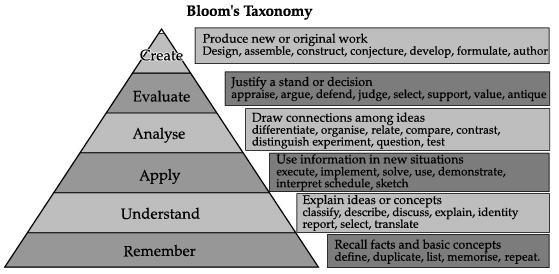Teaching: Previous Year Questions | Teaching Aptitude for Teaching Exam - B.Ed Entrance PDF Download
Q1: A teacher wants to assess the student's performance and wants to give immediate feedback. Which software you will select for the assessment? (December 2023)
(A) Kahoot
(B) Plotagon
(C) Screen-casto-matic
(D) Animaker
(E) Quizziz
Choose the correct answer from the options given below:
(a) A, B & D only
(b) C, D & E only
(c) B & C only
(d) A & E only
Ans: (d)
Sol: (A) Kahoot: It is an online game-based learning platform, commonly used for creating interactive quizzes and assessments.
(B) Plotagon: It is an animation tool that allows users to create animated videos. While it's a creative tool, it may not be directly suited for immediate assessment and feedback.
(C) Screen-casto-matic: It is a screen recording tool, primarily used for capturing and recording screen activities. While useful for certain purposes, it may not be the best choice for immediate assessment and feedback.
(D) Animaker: It is another animation tool, similar to Plotagon. It is more focused on creating animated presentations rather than immediate assessment.
(E) Quizziz: It is an online platform for creating and delivering quizzes. It provides immediate feedback to students and is designed for assessment purposes.
Given that the teacher wants to assess student performance and provide immediate feedback, the most suitable choices are (A) Kahoot and (E) Quizziz. Therefore, the correct answer is (d) A & E only.
Q2: The learning, in which a new behaviour is acquired but is not demonstrated until reinforcement is provided, is known as (December 2023)
(a) Observational learning
(b) Social learning
(c) Latent learning
(d) Moral learning
Ans: (c)
Sol:
- The learning in which demonstration is not done until it is reinforced or required is called latent learning. This is a type of observational learning.
- Observational learning is a type of learning in which a child learns through observation of their surroundings.
- Social learning was introduced in the 1970s. This says that a child or a person learns from the social context by observing an imitation. This learning is based on cognitive learning theory.
- Moral learning is the learning of moral values or ethics.
Q3: In Charlotte Danielson's framework for teaching, the domain of 'Planning and Preparation' has the following components: (December 2023)
(A) Organising physical space in classroom
(B) Setting instructional outcomes
(C) Designing student assessments
(D) Demonstrating knowledge of content and pedagogy
(E) Demonstrating knowledge of resources
Choose the correct answer from the options given below:
(a) C & E only
(b) A, B & D only
(c) B, C, D & E only
(d) A, B, C, D & E
Ans: (c)
Sol:
Components of Professional Practice Domain 1:
Planning and Preparation Component.
Component 1a: Demonstrating Knowledge of Content and Pedagogy - Knowledge of content, Knowledge of prerequisite relationships, Knowledge of content-related pedagogy.
Component 1b: Demonstrating Knowledge of Students - Knowledge of characteristics of age group, Knowledge of students' varied approaches to learning, Knowledge of students' skills and knowledge, Knowledge of students' interests and cultural heritage.
Component 1c: Selecting Instructional Goals - Values Clarity, Suitability for diverse students, Balance.
Component 1d: Demonstrating Knowledge of Resources - Resources for teaching, Resources for students.
Component 1e: Designing Coherent Instruction - Learning activities, Instructional materials and resources, Instructional groups, Lesson and unit structure.
Component 1f: Assessing Student Learning Congruence with instructional goals, Criteria and standards, used in planning.
Q4: Which scheme of the Ministry of Education, Government of India, uses Artificial intelligence to make learning more personalised and customised, as per the requirements of the learners? (September 2022)
(a) NEAT
(b) NEET
(c) SWAYAM
(d) SWAYAM PRABHA
Ans: (a)
Sol: NEAT or National Educational Alliance for Technology is an Indian government initiative to promote artificial intelligence in learning, to make the learning more personalised and custom.
Facts about NEAT / Key points:
- Based on the PPP or public-private partnership model of the Government of India and Ed-Tech companies of India.
- Currently, the government has launched the third version, which is called NEAT 3.0.
- This is a single platform for learning for the socially and financially backwards category of the country.
- The main objective of this initiative was to promote digitalisation and artificial intelligence in learning.
- All India Council for Technical Education is the implementing agency for this initiative.
- This initiative was supported by the New Education Policy, 2020, in which a National Education Technology Forum was established to support and promote technology in learning.
- Initiative is considered a bridge between Ed-Tech companies, educational institutions and students.
- Union Education Minister Dharmendra Pradhan launched NEAT 3.0 on 3rd January 2022.
Q5: Given below are two statements, one is labelled as Assertion (A) and the other is labelled as Reason (R)
Assertion (A) : Teachers must encourage students to ask questions.
Reason (R) : Asking questions can create curiosity and develop a passion for learning.
In light of the above statements, choose the most appropriate answer from the options given below:
(a) Both (A) and (R) are correct, and (R) is the correct explanation of (A).
(b) Both (A) and (R) are correct, but (R) is not the correct explanation of (A).
(c) (A) is correct but (R) is not correct.
(d) (A) is not correct but (R) is correct.
Ans: (a)
Sol: For making the classroom interactive and effective, a teacher must encourage students' GENERAL APTITUDE to ask questions that show the attention of students and trial of understanding the content. Asking questions can create curiosity and develop a passion for learning among the students.
Q6: The modality of 'teaching' has to be differentiated from 'training' or 'instruction' in terms of which of the following learning outcomes? (November 2020)
(a) Disciplined and patterned behaviour
(b) Critical and creative thinking
(c) Firm and durable association of ideas
(d) Quick feedback
Ans: (b)
Sol: Teaching includes a high level of creativity and critical thinking, whereas training focuses on skill acquisition and patterned behaviour.
Q7: Identify those features of learner behaviour which are associated with understanding level teaching: (December 2019)
- The student renders facts and information in his/ her own words.
- The student immediately recalls the facts taught.
- The student gives his/her own examples in order to explain a point.
- The student interprets the meanings in various ways.
- The student correctly reproduces the sequences taught.
Select your answer from the following options:
(a) 1, 2 and 3
(b) 2, 3 and 4
(c) 2, 4 and 5
(d) 1,3 and 4
Ans: (d)
Sol: To enhance understanding on the part of learners, the teacher needs to ensure that students are able to write and discuss the information in their own words; are able to identify the related examples; and are able to interpret the meaning of concepts in multiple ways.
Q8: Which of the following is a key to an effective teaching behaviour? (December 2019)
(a) Teacher-mediated dialogue, which helps learners restructure what is being learned.
(b) Eliciting clarification of an answer given by students.
(c) Soliciting additional information about the responses of students.
(d) Promoting a low error rate (high success) contributes to increased levels of students' self-esteem and positive attitude.
Ans: (d)
Sol: For an effective teaching–learning process, the teacher needs to develop self-esteem and self-confidence in learners by increasing the success rate of students. This can be done by ensuring that learners are able to understand the concepts.
Q9: Which of the following sets of statements best describes the nature and objectives of teaching? (July 2018)
Indicate your answer by selecting from the code.
- Teaching and learning are integrally related.
- There is no difference between teaching and training.
- The concern of all teaching is to ensure some kind of transformation in students.
- All good teaching is formal in nature.
- A teacher is a senior person.
- Teaching is a social act, whereas learning is a personal act.
(a) 1,2 and 4
(b) 2, 3 and 5
(c) 1,3 and 6
(d) 4, 5 and 6
Ans: (c)
Sol: Teaching is a social process which is directly related to learning. The aim of teaching is always to bring a change in the behaviour of students.
Q10: Which of the following sets of statements best represents the nature and objective of teaching and learning? (November 2017)
- Teaching is like selling, and learning is like buying.
- Teaching is a social act, while learning is a personal act.
- Teaching implies learning, whereas learning does not imply teaching.
- Teaching is a kind of delivery of knowledge, while learning is like receiving it.
- Teaching is an interaction and is triadic in nature, whereas learning is an active engagement in a subject domain.
(a) 1, 4 and 5
(b) 2, 3 and 5
(c) 1,2 and 3
(d) 1, 2 and 4
Ans: (b)
Sol: 
Q11: Assertion (A): All teaching implies learning. (November 2017)
Reason (R): Learning to be useful must be derived from teaching.
Choose the correct answer from the following:
(a) Both (A) and (R) are true, and (R) is the correct explanation of (A)
(b) Both (A) and (R) are true, but (R) is not the correct explanation of (A)
(c) (A) is true, but (R) is false
(d) (A) is false, but (R) is true
Ans: (c)
Sol: Learning can be derived from any source, and teaching is one of those sources.
Q12: Select the alternative which consists of positive factors contributing to the effectiveness of teaching (June 2016)
List of factors:
- Teacher's knowledge of the subject.
- Teacher's socio-economic background.
- Communication skill of the teacher.
- Teacher's ability to please the students.
- Teacher's personal contact with students.
- Teacher's competence in managing and monitoring the classroom transactions.
Codes:
(a) 2,3 and 4
(b) 3, 4 and 6
(c) 2,4 and 5
(d) 1,3 and 6
Ans: (d)
Sol: The factors that contribute to the effectiveness of teaching are knowledge of the teacher, communication skills and how effectively the teacher can manage the class.
Q13: Assertion (A): The purpose of higher education is to promote critical and creative thinking abilities among students. (June 2016)
Reason (R): These abilities ensure job placements. Choose the correct answer from the following code:
(a) Both (A) and (R) are true and (R) is the correct explanation of (A).
(b) Both (A) and (R) are true but (R) is not the correct explanation of (A).
(c) (A) is true but (R) is false.
(d) (A) is false but (R) is true.
Ans: (b)
Sol: Only creative and critical thinking cannot ensure jobs for students. Subject knowledge is equally important.
Q14: The most appropriate meaning of learning is (December 2013)
(a) Acquisition of skills
(b) Modification of behaviour
(c) Personal adjustment
(d) Inculcation of knowledge
Ans: (b)
Sol: Learning is
- Modification of behaviour.
- Gaining knowledge
- Creating ideas
- Generating new thoughts
Q15: Teacher's role at higher education level is to (December 2013)
(a) provide information to students.
(b) promote self learning in students.
(c) encourage healthy competition among students.
(d) help students to solve their problems.
Ans: (b)
Sol: In higher education, the role of the teacher is to promote self learning in the students. He/she has to play the role of mentor at the higher education level.
Q16: Interaction inside the classroom should generate (December 2012)
(a) argument
(b) information
(c) ideas
(d) controversy
Ans: (c)
Sol: The conversation in the class or classroom communication should be creating new ideas. Every child has a different level of thinking and creativity. Discussion and practical participation create different ideas and knowledge.
Q17: If you get an opportunity to teach a visually challenged student along with normal students, what type of treatment would you like to give him in the class? (June 2012)
(a) Not giving extra attention because the majority may suffer.
(b) Take care of him sympathetically in the class-room.
(c) You will think that blindness is his destiny and hence you cannot do anything.
(d) Arrange a seat in the front row and try to teach at a pace convenient to him.
Ans: (d)
Sol: If a child or learner is having a problem with his visibility, and he is sitting in a class of normal students, a teacher should make a comfortable environment for him to study better. Changing the seat by setting it in the front row is a good option for the same. Apart from this, teaching–learning aids can be used to teach, which will be more useful in the learning of that child as well as the other ones.
Q18: The primary duty of the teacher is to (December 2009)
(a) raise the intellectual standard of the students.
(b) improve the physical standard of the students.
(c) help all round development of the students.
(d) imbibe value system in the students.
Ans: (c)
Sol: Teaching and learning, or education, aim at the overall development of the student. Thus, the primary goal or focus of every teacher should be on helping students’ overall development, i.e., physical, emotional, cognitive, mental, values, etc.
Q19: Which region of the brain is involved in our ability to learn new information, particularly if it is verbal? (November 2021)
(a) Cerebrum
(b) Hippocampus
(c) Pons
(d) Thalamus
Ans: (b)
Sol: The hippocampus, located in the temporal lobe, plays a key role in forming, organising, and storing new memories, especially those related to learning and verbal information.
Q20: A teacher decides to form six groups of students and assigns a sub-theme to each group for discussion and reporting. Which kind of communication model will best describe his/her strategy in this regard?
(a) Transactional model
(b) Horizontal model
(c) Linear model
(d) Interactional model
Ans: (c)
Sol: Transactional model of communication involves continuous communication or exchange of ideas between the sender and receiver. The best example will be any type of face-to-face meeting.
Q21: A college level assistant professor has planned his/ her lectures with an intent to develop cognitive dimensions of students centred on skills of analysis and synthesis. Below, given are two sets of items Set-I consisting of levels of cognitive interchange and Set-II comprising basic requirements for promoting them. Match the two sets and indicate your answer by choosing the correct alternative from the code: (June 2016)


(a) a
(b) b
(c) c
(d) d
Ans: (c)
Sol: For developing memory dimension, teachers/a teacher should promote habits of taking notes. For developing an understanding dimension, teachers/a teacher should give the opportunity to differentiate between examples and non-examples. For developing a reflective dimension, teachers/a teacher should promote critical analysis discussions of topics being discussed in lectures.
Q22: Which of the following is the highest level of cognitive ability? (June 2015)
(a) Knowing
(b) Understanding
(c) Analysing
(d) Evaluating
Ans: (d)
Ans: Evaluating is the highest level of cognitive ability from the given options. Levels of Bloom’s taxonomy are:
Q23: Which of the following is not a prescribed level of teaching? (December 2014)
(a) Memory
(b) Understanding
(c) Reflective
(d) Differentiation
Ans: (d)
Sol:
There are only three levels of teaching,
Level 1: Memory (Thoughtless)
Level 2: Understanding (Thoughtful)
Level 3: Reflective (Highly Thoughtful)
Q24: Who among the following propounded the concept of paradigm? (June 2014)
(a) Peter Haggett
(b) Von Thunen
(c) Thomas Kuhn
(d) John K. Wright
Ans: (c)
Sol: The concept of paradigm was developed by Thomas Kuhn. Paradigm refers to a set of concepts through patterns and various other methods and information.
Q25: The Verstehen School of Understanding was popularised by (December 2013)
(a) German Social Scientists
(b) American Philosophers
(c) British Academicians
(d) Italian Political Analysts
Ans: (a)
Sol: The Verstehen School of Understanding was popularised by German philosophers. Max Weber was considered the founding father of this method of understanding.
Q26: Which one is the highest order of learning ? (June 2013)
(a) Chain learning
(b) Problem-solving learning
(c) Stimulus-response learning
(d) Conditioned-reflex learning
Ans: (d)
Sol: According to Bloom’s taxonomy, evaluating is the highest level of cognitive ability from the given options. Levels of Bloom’s taxonomy are:

Q27: Micro teaching is more effective (December 2009)
(a) during the preparation for teaching practice.
(b) during the teaching-practice.
(c) after the teaching-practice.
(d) always.
Ans: (b)
Sol: Micro teaching is a part of the teachers’ training programme. This type of teaching is included in various teachers’ training courses like B.T.C., B.Ed., D.El.Ed., etc. In this method, a situation like a real classroom is created for practice.
|
29 videos|48 docs|11 tests
|
FAQs on Teaching: Previous Year Questions - Teaching Aptitude for Teaching Exam - B.Ed Entrance
| 1. What are some effective teaching strategies for engaging students in the classroom? |  |
| 2. How can teachers differentiate instruction to meet the diverse needs of students in the classroom? |  |
| 3. What is the importance of formative assessment in the teaching process? |  |
| 4. How can teachers create a positive classroom environment that enhances student learning? |  |
| 5. What are some professional development opportunities available for teachers to enhance their teaching skills? |  |





















